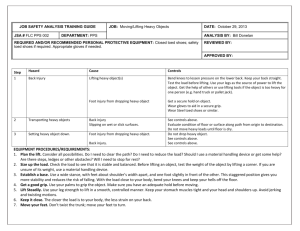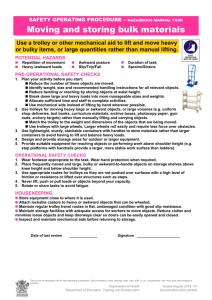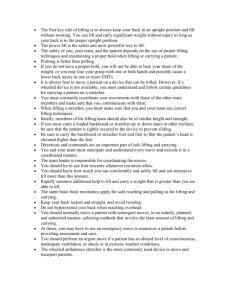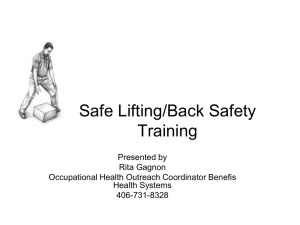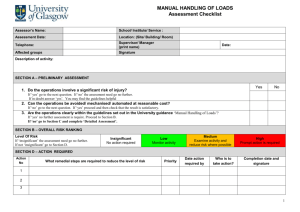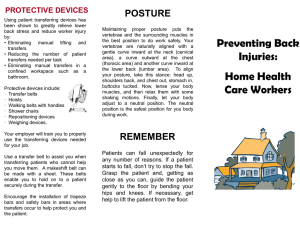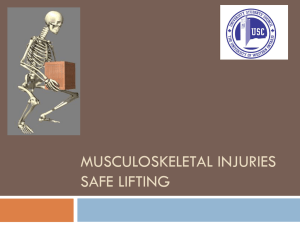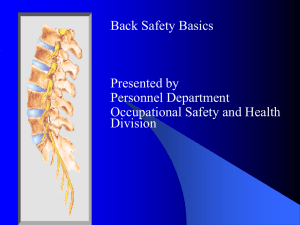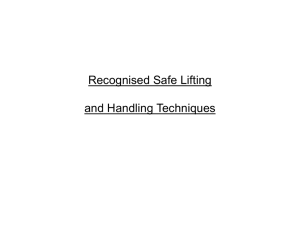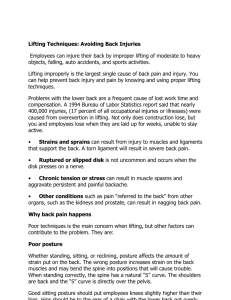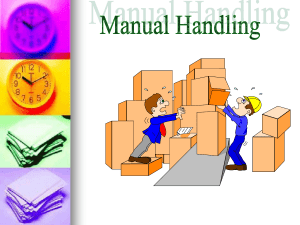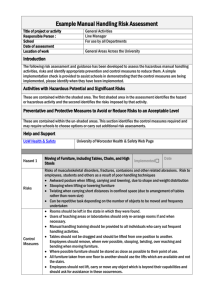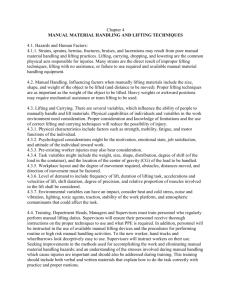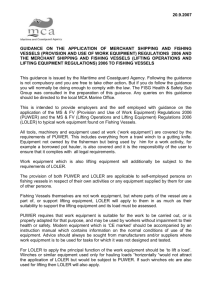Proper Lifting Techniques: Back Safety
advertisement
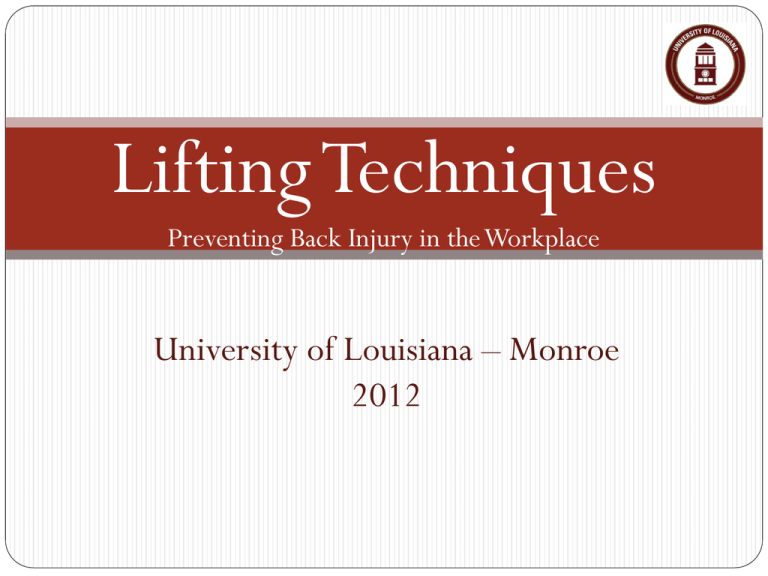
Lifting Techniques Preventing Back Injury in the Workplace University of Louisiana – Monroe 2012 Lifting Process BEFORE YOU LIFT Plan Your Route: Path clear? Trip hazards removed? Dry? Assess the Load: Too heavy? Can I use a hand truck or forklift? Can I slide it? WHEN YOU LIFT Lift It Right: Position your body close to the object. Keep your back straight. Move It Right: Don't twist your back. Lower It Right: When you put the load down, bend your knees not your waist. GET HELP IF YOU NEED IT Work Together: Don't be a hero. Communicate with your partner! 2 Plan Ahead Size up the load: Can it be split into multiple loads? Smaller loads cause less strain on the back. Can you slide it rather then lift? Use material handling equipment if load is too heavy: Forklifts Hoists Dollies Avoid using lower rack for moderately heavy to heavy items or awkward items. Get help when lifting heavy, awkward, or long items. 3 9b Basic Rules of Good Lifting Size up the load before you lift. Can you lift a corner? Can you get to the item? Do you need to move something to gain better access? Bend your knees. Get a good hand hold. Center yourself over the load. Lift straight up - let your legs do the work. Don’t twist or turn. 4 1a Basic Rules of Good Lifting (cont.) Have a clear path. Set the load down properly. Always push a cart or dolly. Get help for long loads. Split up heavy loads when you can. Pushing a load is easier on the back; easier to control. 5 1b Never Twist or Turn When Lifting Adds strain to the back’s discs, muscles, ligaments, tendons. Plan your lift to avoid awkward positions. Set load down if you’re losing your grip. Don’t twist and turn or juggle load to regain grip. Keep back as straight as possible. 6 5a Carrying The Load Ensure a clear path. Ensure a place where load can be set down. Check for stability of load. Can you get a good grip? Use mechanical equipment if load is too heavy. Get help if load is too heavy - lift at the same time to keep load balanced. 7 6a Lowering the Load Bend the knees to let leg muscles support the weight. Slowly lower it; do not drop the load. Avoid sudden movements. Lower the load at the same time if working with a partner. 8 7a Awkward Lifting Lifts that are: Above the shoulders Below the knees At arms’ length 9 Analysis Tools The closer to the body the more Strength you have. L&I Lifting Calculator Other tools: American Conference Group of Industrial Hygiene (ACGIH) Lifting Threshold Limit Value (TLV) National Institute of Occupational Safety & Health (NIOSH) Lifting Equation 10 Principles for Reducing Heavy Lifting Reduce the weight Increase the weight (to balance load) Use mechanical assistance Slide instead of lift Team lifting 11 Principles for Reducing Frequent Lifting Use mechanical assistance Avoid unnecessary lifting Use mobile storage shelves 12 Principles for Reducing Awkward Lifting/Reaching Remove obstacles Slide closer Reduce shelf depth Reduce package size Use mechanical assistance Team lifting 13 Reducing Awkward Lifting/Reaching Reduce package size 14 Principles for Reducing Awkward Lifting/Bending Use mechanical assistance to raise the load Add handles Arrange storage Avoid unnecessary lifting 15 Reducing Awkward Lifting / Reaching Above Shoulders Arrange storage Use mechanical assistance Use a rolling stair or “safety ladder” 16 Other Factors in Back Injuries Age of employee Improper postures when sleeping, standing, sitting Physical condition of employee Repetitive motions 17 10a Report any accident/incident immediately using the proper Forms (DA2000 for employees; DA3000 for guests, students, and vendors). Contact the ULM Safety Office at 342-5177 ULM Police 342-5350 18
